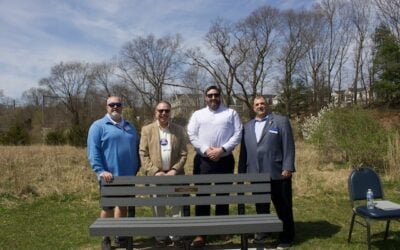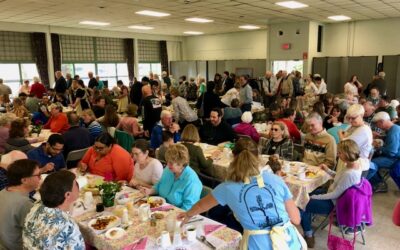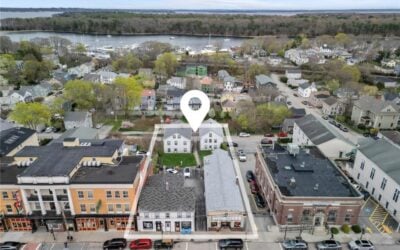Continentals split over plan to sell 250-year-old house
The head of the Varnum Continentals wants to sell the Varnum House, the historic home-turned-museum on Peirce Street adjacent to Town Hall that was once owned by a general who served under George Washington in the American Revolution. It now serves as an elementary school field trip locale.
“We don’t have the resources to responsibly operate and maintain two historic buildings and museums,” said Patrick Donovan, president of the Varnums. The other building is the Varnum Armory on Main Street, which they also own.
The decision has caused a rift in the 116-year-old nonprofit organization founded to foster respect for U.S. history and encourage patriotism.
The plan would be to sell the house and use the proceeds to create an endowment for the Varnum Armory Museum. While the museum has housed a military history museum for many decades, in recent years it has become a showcase for Rhode Island military artifacts from the Revolutionary War through to the “war on terror” following the 9/11 attacks.
For Donovan, creating an endowment and focusing efforts on the museum makes more sense than trying to hang on to both buildings and having neither the money nor the volunteer power (they are an all-volunteer organization) to do either well.
“The sale of one of the buildings would … immediately ensure the long-term survivability of the organization,” Donovan said in an interview. “I think the Armory has the best chance and the most appeal.”
He noted the prominence the museum has gained in the past few years, developing a textile and document conservation lab and collaborating with state and national entities, including the current collaboration with the R.I. State House to showcase the Gettysburg and Bull Run guns.
“I feel like the Armory has broader appeal versus a house museum,” said Donovan. He mentioned a recent article in Preserve R.I. that spoke of the challenge faced by house museums in 2023, with people not as interested in them as they once were, and the costs associated with keeping up an old house.
“There’s also much, much more value in the museum collection – historical and financially,” Donovan said. The museum, which occupies the basement of the Armory, was a mess 10 years ago, according to Donovan, who also serves as the museum’s executive director. “I’m forever scarred from my time when I first arrived,” he said, recounting how exhibits were moldy and full of moth larvae. “Artifacts were lost because of that neglect.”
The Armory itself was built in 1913. The main floor has been a rental venue over the years (including for an EG News event in Sept. 2022), and the entire building is open for touring a couple times a month. Private, paid tours are available on request.
The Varnum House was built in 1773 for James Mitchell Varnum, a young lawyer who then went on to serve as a general under Gen. George Washington in the Revolutionary War. According to the house website HERE, “As a prominent figure in the Revolutionary War and early-American politics, Varnum attracted a ‘who’s who’ of guests to his mansion including George Washington, Marquis de Lafayette, Rochambeau, John Sullivan, Nathanael Greene, and many others.”
He was also behind the formation of the first Black regiment in the U.S.
Varnum himself lived only 10 years past the war, dying at age 40 in 1789. The house remained a private residence until the Varnum Continentals bought it in 1939 and turned it into a museum. The property, right across the street from Town Hall, also has a large “yard” enclosed by high walls, creating a private oasis effect. In recent decades, the house has opened for field trips and house tours and the property is occasionally rented out for events.
Both the house and the Armory are on the National Register of Historic Places.
The idea of selling the house is anathema to Mark Trimmer, a life-long member of the Varnum Continentals whose grandfather – George Arthur White, Jr. – was one of the two men who founded the group after a rupture with the Kentish Guard.
“I’ve been involved since I was born. My mother stopped by the Varnum Armory on the way home from the hospital to show her new baby to my grandfather,” Trimmer said, noting that he played at the Armory and at the house as a kid. “It’s in my blood. It’s been part of my life for 63 years.”
Trimmer said he and Donovan worked side by side at the museum after Donovan joined the Varnums, putting in new flooring, and working on the electrical and plumbing. It had been a fruitful time and Trimmer welcomed Donovan’s enthusiasm.
Things changed a few years ago. Trimmer became ill and had to step back from duties for a while and then Covid hit. Trimmer said that was when Donovan began to make changes. Donovan doesn’t disagree.
“I started ringing the alarm bells about our long-term sustainability at the beginning of Covid,” Donovan said. “I felt like we had way too many assets and property for this little volunteer organization.”
He thought the Varnums should either merge with a larger, better-funded organization or “shrink our assets.”
Donovan and a couple of other members of the board of trustees did talk with one organization (he declined to name it) about a merger but that organization did not feel it had the bandwidth and the discussions ended. Which left shrinking.
In a letter posted on Facebook, Donovan outlined what he sees as all the challenges facing the Varnums if things stay as they are now, including capital needs at both buildings, such as new roofs, heating systems, and handicapped accessibility.
The Varnum Armory and the Varnum House have both been recipients of large Champlin Foundation grants over the years – $360,000 in the last five years alone. The Rhode Island-based foundation provides “bricks and mortar” grants for historic buildings. But Donovan said depending on Champlin to keep funding them was unwise.
Trimmer, alternatively, said Donovan was painting too bleak a picture about the work that needs to get done, the lack of volunteers, and the overall financial picture.
He and others have organized a new group, Friends of the Varnum House Museum, “to preserve, promote, and maintain the Varnum House Museum … as [a] publicly accessible, non-profit history museum under the Varnum Continentals organization.” They have also collected letters from a variety of supporters, including former Gov. Don Carcieri (RI Governor Don Carcieri – Support Letter), Varnum Continentals past president Chris Feisthamel (Chris Feisthamel – Support Letter), and commander of the Kentish Guard Theo Aschman (Theo Aschman – Support Letter).
Trimmer’s worry is the house would be sold, gutted and rebuilt by private interests.
Donovan said the house can be protected through a historical easement (the EG Historic Preservation Society had such an easement in place when they sold the Old Jail on Water Street to a private developer looking to open up a boutique hotel – read more HERE).
“I think the best way to restore the house is through a well-crafted historical easement,” said Donovan. He said such an easement could be tailored to protect everything that is historically relevant at the property. Trimmer, for his part, does not think such an easement would be strong enough to protect the property as the Varnum Continentals have done these past 84 years and that clashes with what he feels is the duty of their organization.
“To me, we are merely stewards of this historical house and its contents,” he said.
What will happen now?
At this point, Donovan said, he is not going to call for a vote on the sale of the house despite his strong feeling that’s the right thing to do.
“I think a split either formally or operationally is our best path forward,” he said, referring to the Varnum House Museum as a separate entity. “But their side would need to agree to it.”
Donavan added, “A lot of people are very passionate about who we are and what we have as an organization. But you still have to look at this as a modern business. As president, it is my duty to look ahead and tend to the long-term viability of our small, all-volunteer organization.”
Editor’s note: It happens both the armory and the house will be open this weekend for tours. The Varnum House Museum will be open for tours from 10 a.m. to 3 p.m. both Saturday and Sunday; there will also be cannon drills Sunday on the grounds. The Varnum Armory Memorial Museum will be open Sunday for tours from 10 a.m. to 2 p.m. Find out more about both HERE.
NOTICE: We are having technical difficulties with our comments. We are working to fix it. In the meantime, if you are not seeing comments here, try holding down the shift key while refreshing the page.






 Subscribe
Subscribe
Both Varnum Continentals historic properties are important. The Varnum House has been closed since early January, following the resignation of the House Vice President, who had experienced a personal tragedy and was unable to continue. It has been languishing for 10 months without leadership until just last week, when I was elected as House Vice President.
I respect the President’s position (we disagree, but I do respect it), and as a Varnum member of about 20 years am proud of what he (with many volunteers) accomplished. Museums do need to be reimagined and reinvented, and that it exactly what the Varnum House team is doing right now.
We (the House Team) did not know until reading this post that the President is not putting the House sale up for a vote (at least not right now). As you can imagine, planning for anything beyond the immediate future has been severely hampered by this imminent threat to our existence.
We’ve got work to do! I’ll keep the EG News up to date on our plans and progress to ensure that the Varnum House Museum is a sustainable, vital part of the local and historic community. Thanks to everyone who has already stepped forward to support and assist.
Joanne Breslin, Vice-President
James Mitchell Varnum House Museum
What a shame it would be to sell this house. Even thinking about doing it tells me that the leadership needs to change at Varnum because it is not thinking about this place the way it should be thought. It seems like more emphasis is being put towards the armory because of personal interest by Donovan. I hope the organization has a change of thought and a change in leadership. And no the historic preservation would not do much to keep this place true to what it is. They would probably even let a developer subdivide the lot and build another house on it as we have seen happen in the same neighborhood in the last 2 years, and will probably be happening in the recent sale of 74 division street. Call it like it is.
You couldn’t be more right about the danger posed by any sale of the house. For historical resources such as that, once lost, they cannot be regained, the house cannot be rebuilt, so all meaning that can generated from it would vanish. The most important next step is to ensure that it is protected and in the hands of people who appreciate both what it is and what it can be.
As a public history professional, with more than 15 years of experience working in the field, including as historian at Colonial Williamsburg, and teaching public history practice (I teach at Johns Hopkins University, but live mainly in East Greenwich), I’m not surprised that the Continentals cannot make a go of the Varnum House as a museum, but strongly disagree with the assumption that it is not a viable site for a vibrant, relevant mechanism to spark history engagement and bring a steady, sustainable audience to East Greenwich. There are two primary flaws here, which both serve to underscore fundamental misunderstandings of how history works with modern audiences — especially when it comes to the history of the American Revolution and Founding era. The first is that, for some reason, the Armoury has the potential for a broader appeal. Quite to the contrary. We know that anything so strictly associated with military history immediately shrinks audience appeal, as it represents both a narrow approach to understanding a past — through its armed conflicts — and the narrow demographics of those who engaged in it. The latest data shows that such institutions are steadily losing visitors as the demographic that generally supports them — 65+, white — also shrinks. There is, in fact, no evidence for growth potential in such sites.
However, a house museum, if more broadly conceived as a campus for audience interaction with a meaningful past, one not so dependant on nebulous outcomes like promoting patriotism, can be a generator of ongoing interest for diverse audiences who want to understand better the complexities of America’s founding and how it relates to them. The Varnum House represents the perfect opportunity for such an approach, which is yielding benefits for newly energized institutions across the country. The key is to focus on engagement and interaction with historical issues that matter, neither of which requires massive financial investments, just the right kind of intellectual commitment.
That said, a sale of the Varnum House, or at least its transfer to a group with the vision and vigor to see its massive potential, rather than the narrow, ultimately unworkable scope of the Continentals, would serve both that organization and the community at large.
I’m a great admirer of what Patrick Donovan has accomplished with the Varnum Armory; however, like most people I’d hate to see the Varnum House turned into a B&B–or worse–simply because Patrick and the Varnum Continentals haven’t the interest or capability to maintain both properties. So, yes, the Varnum Continentals should indeed divest themselves of the Varnum House, but not as a money-making venture.
Fortunately, there are existing organizations that might be interested in coming to the rescue: Historic New England, The National Trust for Historic Preservation, and even the National Park Service. I admittedly know nothing about how these organizations acquire properties. Do they pay? Or do they have to be paid? Whatever the case, the guiding principal should be to preserve the historically important Varnum House for future generations, not to raise money for an endowment for the Varnum Armory. That’s a separate issue, and should have nothing to do with the property on Peirce Street.
I am not an East Greenwich “native”, but I have lived here for 60+ years, and have much appreciation for historic value of the many buildings here in town. I believe that the Varnum House should be protected in every possible manner.
It seems like everyone involved is working toward ensuring the long term preservation of these awesome buildings. I hope they can come to a resolution soon!